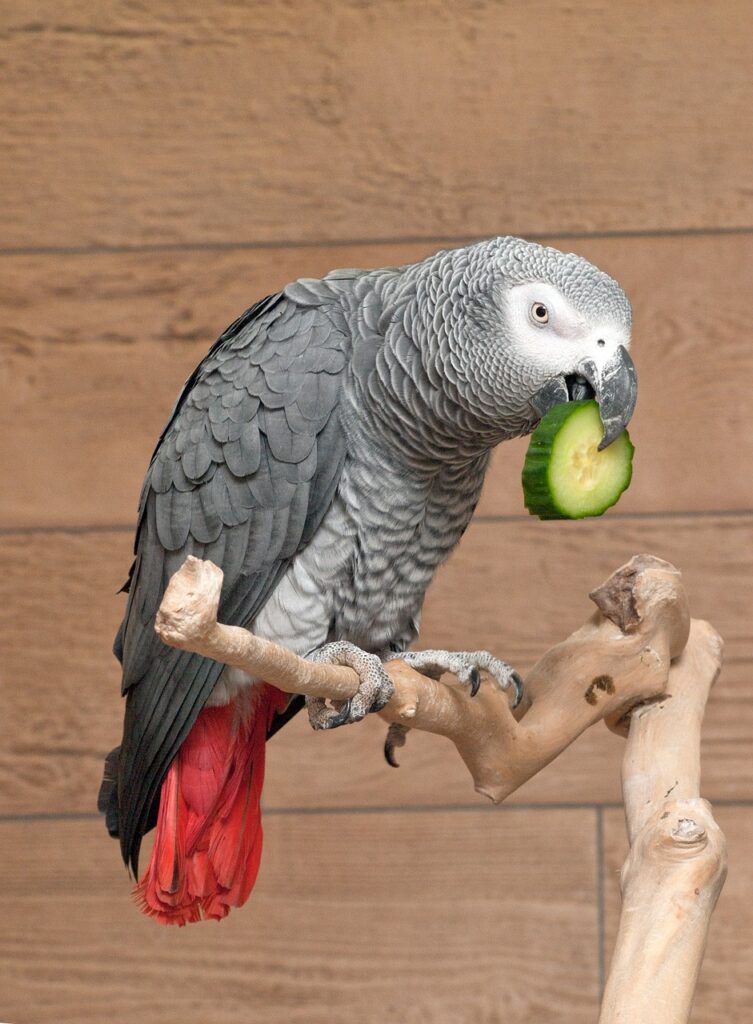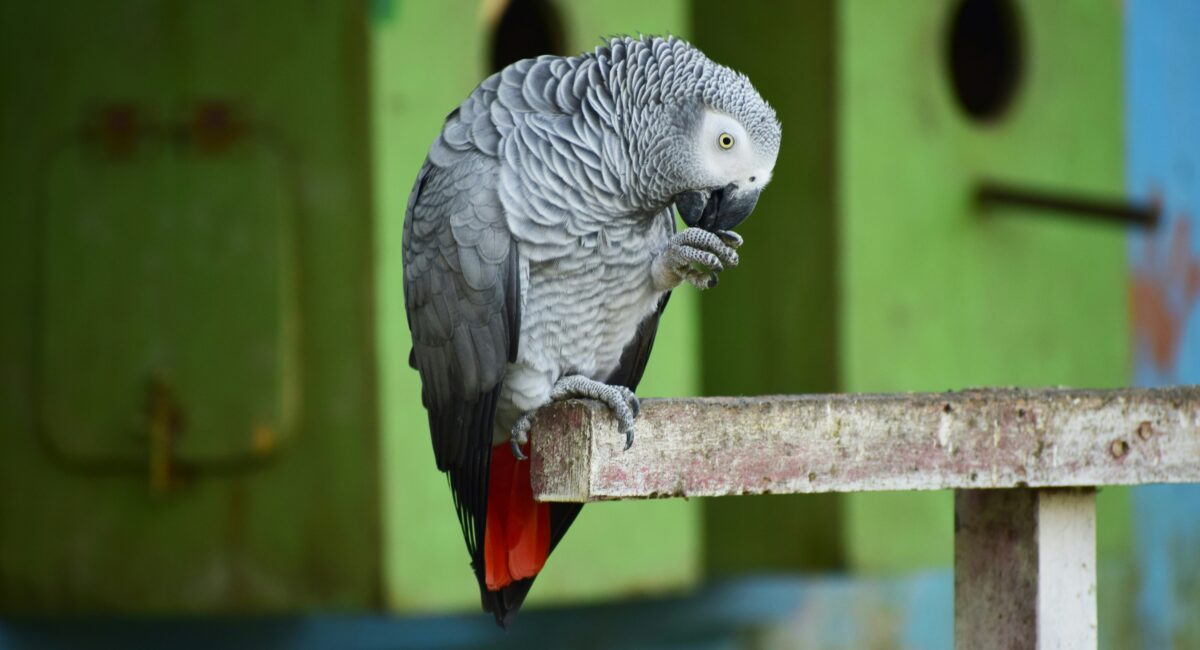All You Need to Know About The African Grey Parrot
You might have heard about African Greys for their intelligence, charm, and their distinctive personalities. They are one of the most popular parrot breeds known for their intelligence and the ability to mimic human languages. In fact, they can literally have a full conversation with you if you train them properly. This wonderful bird has surprised me in many ways, and that’s why I took a step to write all you need to know about the African Grey parrot.
Physical Characteristics
| Size | 12 – 14 inches. |
| Weight | 418-526 grams. |
| Body Color | Predominantly gray. |
| Tail Color | Bright red or maroon. |
| Wingspan | 18 – 20 inches. |
| Lifespans | 50 – 60 years. |
| Personality Traits | Social, affectionate, and playful. |
| Sexual Maturity | 4 – 7 years. |
| Clutch Size | 2 – 4 eggs. |
| Breeding Seasons | October to March, but this can vary based on the environment. |
Origins and History
Captured from their name, these wonderful parrots hail from the rainforest of West and Central Africa. Their natural range includes some countries like Ivory Coast, Ghana, Cameroon, and Congo. There are mainly two subspecies of African Grey, the Congo African Grey, and the Timneh African Grey. The Congo is quite larger than Timneh. These parrots inhabit mainly rainforests, mangroves, and gallery forests.
About their historical records, these remarkable birds have been known and admired since ancient times. History tells us, they used to be kept as pets by ancient Egyptians, Greeks, and Romans. In the 15th century, they were introduced to Europeans and gained popularity for their intelligence and the ability to mimic human speech.
In modern times, they have been subjected to numerous studies. Researcher Irene Pepperberg from Harvard University working with an African Gray named Alex is notable, demonstrating their advanced problem-solving skills and understanding of their languages.
Intelligence and Personality
They are very popular for their intelligence and are often described as the “Einsteins” of the bird’s world. Isn’t it funny? They are able to understand and mimic human speech with astonishing accuracy. You might be surprised that many studies have shown they can associate words with their meaning and even form simple sentences. A popular African Grey parrot on YouTube named Apollo can identify colors, materials, and sounds of different kinds. So there is no wonder that they are one of the most intelligent parrot breeds from the parrot words. In my opinion, they have achieved the number one position for their intelligence.
They are not only intelligent but also have some unique personalities. They can be very affectionate and playful. Because of their higher intelligence, they get bored very quickly, for which feather plucking is a common behavior among them. That’s why you have to keep them busy with foraging and puzzle toys. Beyond that, sometimes they become very moody and aloof. Each bird has its quirks, and I think getting to know their individual character is part of the joy and owning one.
Common Behaviors
Before owning an African Grey, it’s better to know their common behavior. I figured there are 4 common behaviors you should know before owning them. This might help you to better understand their traits:
- Mimicking Sounds: As I said earlier, they have become more popular because of their ability to mimic sounds and human speech. They literally can associate words with their meanings and form a sentence. You can have a wonderful conversation with this adorable parrot. The funny thing is, that they often replicate household noises like phone rings, and doorbells, and even give commands to “Alexa” to play music. But you have to give proper guidance and training to achieve this kind of behavior from your African Grey parrot.
- Feather Plucking: Because of their high intelligence and energy, you have to keep them busy with various toys and puzzles. Otherwise, these intelligent birds can become bored or stressed relatively easily, which can lead to feather-plucking behaviors. So it is highly recommended to provide mental stimulation and a stress-free environment for them.i6
- Social Interaction: In the wild, they live in flocks, which provides them with constant social interaction. That’s why they are highly social birds known for their strong bonding with humans. When you bring these social butterflies into your home, you’re essentially becoming their flock. They crave attention and companionship not only from other birds but also from their human family. That’s why talking to them, playing games, and training them with new tricks are essential for their mental health. So, if you’re considering an African Grey, be prepared for a bird who needs a lot of your time and attention as they are pretty high-maintenance. In return, you will get a smart, affectionate, and entertaining companion.
- Problem Solving: If you already own these little Einsteins, then you already know what kind of toys you need for them. These incredibly smart birds love solving puzzles and engaging in mentally challenging activities. If you think about wild African Grey, they spend a lot of time foraging, which keeps their brain sharp. So allow them to spend at least 2 hours out of the cage daily with various types of toys and exercise.
Diet Requirements
When thinking about the wild African Grey, they usually eat fruits, seeds, leaves, insects, bark, and flowers. So you can combine all of them together and offer high-quality pellets for them. Pellets are nutritionally well-balanced and formulated to provide essential vitamins and minerals. Other than that some fruits such as apples (avoid the seeds), bananas, berries, and leafy veggies like kale, arugula, bell peppers, and carrots can be provided to them. It’s better to provide some kind of seeds and nuts only for their treats. Pistachios are one of their favorite nuts, and you can offer them during the training seasons.

Some calcium supplements are very important if you are breeding the African Grey. You can provide some cuttlebones which is a very good source of calcium. You also can consult with an avian vet for any special recommendation. Cooked grains like quinoa, brown rice, and oats, as well as legumes like chickpeas, can be additional nutrients and varieties.
Also, you should know that the food could be toxic for them. It’s better to avoid chocolate, caffeine, alcohol, roasted nuts, and food high in salt. Avocado and apple seeds are also toxic and could cause serious injury to your bird. I will highly recommend you provide high-quality pellets for their overall health and choose well-reputed brands.
Read additional article:
8 Reasons Pellets Are Better Than Seeds for Your Pet Birds
Housing Or Cage Requirements
African Grey can live up to 50 – 60 years, so owning one can be a long-time commitment. They are medium to large size parrots and they need spacious cages with ample room for flying and climbing. Here are some cage requirements based on my research:
| Cage Size | 36” L x 24” W x 48” H (minimum requirements) |
| Bar Spacing | ¾” – 1” to prevent head entrapment and escape. |
| Cage Material | Sturdy, non-toxic material. I would prefer stainless steel. |
| Breeding Box | 18”L x 18”W x 24” H (minimum requirements) |
| Breeding Box Material | Solid, non-toxic wood |
| Door Size | 12”W x 18” H |
| Cage Placement | Safe and quiet area; avoid drafts, direct sunlight, and sudden temperature changes. |
| Cleanliness | Regularly change water, remove waste food, and clean perches at least once in a week to maintain hygiene. |
| Out-of-Cage Time | At least 2 hours daily but I prefer longer around 4 – 5 hours. |
Common Health Problems
However, like all other birds, this intellectual bird faces some health challenges. Some common health issues are Psittacine beak, Respiratory infections, Feather plucking, aspergillosis, hypocalcemia (calcium deficiency), obesity, giardia, and vitamin-A and vitamin-D deficiency. Feather plucking is a behavioral issue and vitamin A and vitamin D deficiency can be prevented by providing a wide selection of foods as well as some vegetables. Now, I’m going to provide some symptoms and causes of other health problems:
- Psittacine Beak: A very common infection that affects their beak and feathers. Sometimes it harms their immune systems. You might see feather loss, beak deformities, and may be secondary infection due to a poor immune system.
- Respiratory Infection: Common symptoms are sneezing, coughing, nasal discharge, and breathing difficulties.
- Aspergillosis: This is a fungal infection and symptoms are labored breathing, loss of appetite, and lethargy.
- Obesity: Happens due to high in seed-mixes of their diet and low in fruits and vegetables. This can lead to liver disease and heart problems.
- Giardia: This is a common parasite infection and can cause diarrhea, weight loss, and feather plucking.
It’s better to keep in touch with your avian vet for early detection. Sooner you find the problem, the easier it is to prevent it. Always get suggestions from the vet for their proper treatment, and try not to find any solution on the internet.
Training Tips for African Grey Parrot
All birds are different, so training them can be quite challenging. You have to build trust in your bird before training them, and that makes things easy. Always use positive reinforcement such as treats and praise to reward desired behaviors. I would suggest pistachios because it’s their favorite nut. Remember, African Grey responds very well to positive reinforcement.
Consistency and patience are also a key factor to training any kind of parrot. Be consistent with your training and take small steps to celebrate each success. Repetition helps them learn smoothly and understand what is expected. So be patient while you train these intelligent birds.
Beginners Tips for New African Grey Owners
If you have decided to bring this wonderful intelligent parrot home then you have to make a long-term commitment. Here I’m going to share some tips for your new African Grey parrot.
- Get some toys before you bring them home. Try to buy a variety of toys that challenge their minds, such as puzzle toys, foraging toys, and interactive toys. Creating a stimulating environment is important for these highly intelligent creatures.
- Create a routine for their daily feeding. This routine helps your parrot to understand what to expect each day. If you can’t create one, follow the table I provided down below:
| Time | Food Type | Quantity | Notes |
| 7.00 am | Fresh fruits & vegetables | ½ cup | Include a variety such as apples, carrots, spinach, and broccoli. Remove uneaten portions after a couple of hours. |
| 9.00 am | Pellets & fresh water | ¼ cup | High-quality pellet diet formulated for African Grey |
| 1.00 pm | Seeds/Nuts | 1-2 tsp | Use as training rewards or occasional treats. |
| 3.00 pm | Fresh fruits & vegetables | ½ cup | Change the previous one and add new ones. |
| 6.00 pm | Pellets & fresh water | ¼ cup | Change the previous one and add new ones. |
| 8.00 pm | Throw out all the food. | – | Clean all the bowls change everything and prepare for the next day. |
- Try to understand their body language. It is crucial to understand their body and vocal languages because of their needs which help you to respond appropriately.
- They love socialization; try to introduce them to different people, pets, and environments. This might help prevent them from becoming too attached to one person and reduce the risk of behavioral issues.
- In the beginning, keep training sessions short and fun. It’s better to start doing the commands like “step up”, “go around”, and some human mimic languages. Gradually move to more complex tricks and commands.
- I usually suggest all the bird owners keep rotating toys and perches to keep them interesting. Boredom can lead to some behavior issues (feather plucking).
- Note the location of the nearest avian veterinarian and have the travel carrier ready all the time for any kind of emergency. Better to have a band-aid available in your house.


